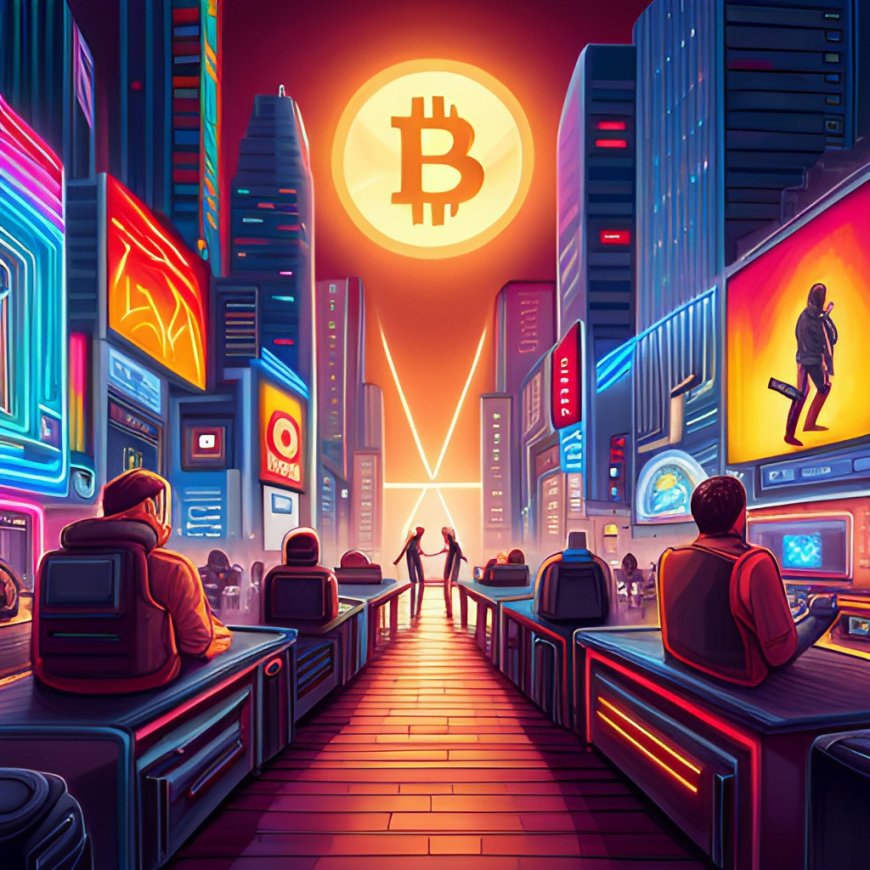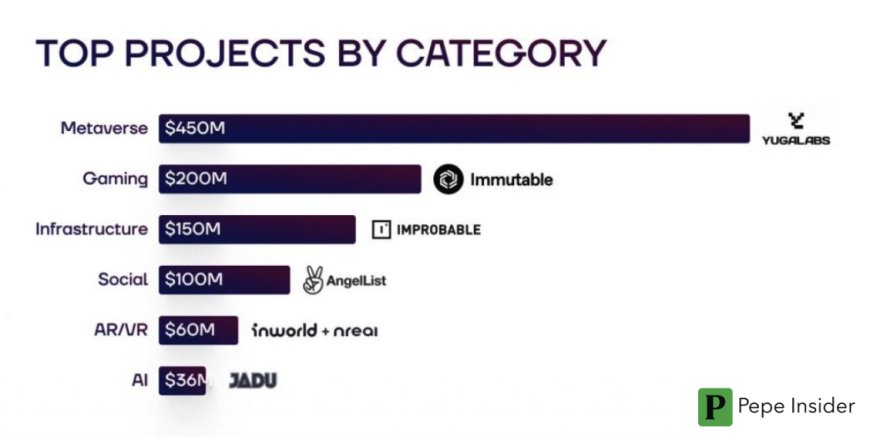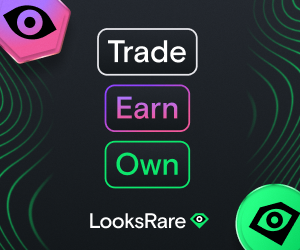How Blockchain Technology is Transforming the Gaming Market
In this digital age, gaming has evolved into an immersive and interactive experience that connects millions of players worldwide. And now, with the rise of Web 3.0, the gaming market is poised for a revolutionary transformation.

Blockchain technology, the backbone of cryptocurrencies like Bitcoin, is making its way into the gaming industry, offering a new level of transparency, security, and ownership. By utilizing decentralized networks, blockchain allows players to truly own and control their in-game assets, creating a sense of empowerment and value.
In 2022, the gaming sector represents nearly half (49%) of the blockchain activity.
The integration of blockchain technology in gaming also opens up new avenues for creativity and collaboration. With smart contracts, players can engage in peer-to-peer transactions, trade virtual items, and even monetize their skills. This innovative approach gives rise to a decentralized gaming economy where players can truly thrive.
As more players become aware of the benefits of blockchain technology in gaming, the demand for Web3 games is skyrocketing.
The web3 gaming landscape is expanding quickly with more than 1.1 million Daily Active Users and over 2,500 active game projects with a staggering market cap of $5.6 billion as of August 2023.
As the gaming industry embraces Web 3.0, we can expect to see a surge in blockchain-based games that redefine the concept of ownership and gameplay. With its decentralized nature and transparent infrastructure, Web3 gaming has the potential to revolutionize the gaming market as we know it. (source: Dappradar and FootPrint)
Growth and potential of the Web3 gaming industry
The Web3 gaming market is experiencing rapid growth and showing immense potential for the future.
The blockchain gaming market size is expanding quickly and is estimated to reach more than $65 billion by 2027 and $301.53 billion by 2030.
One of the main drivers of this growth is the concept of play-to-earn. In Web3 games, players can earn valuable cryptocurrencies or tokens by playing crypto games, completing quests, or achieving certain milestones. This incentive model has attracted a whole new generation of gamers who see gaming as a way to earn a living or supplement their income.
Furthermore, Web3 gaming allows for cross-platform compatibility and interoperability. Traditionally, games are tied to specific platforms, making it difficult for players to switch between devices or transfer progress. With blockchain technology, games can be built to work on multiple platforms seamlessly. This interoperability enables players to access their gaming experiences from anywhere, anytime, without any limitations. (source: Grandview research and FootPrint)
The top chain by user activity and number of games developed is BNB Chain (32%) followed by Ethereum (24%) and Polygon (14.9%).

For investors, the GameFi ecosystem presents a multitude of opportunities, ranging from investing in-game tokens to exploring play-to-earn models and supporting promising projects. However, it's crucial to comprehend that each investment carries its own set of potential returns and risks. Consequently, leveraging comprehensive on-chain analytics becomes indispensable in effectively evaluating investment performance, market liquidity, and user engagement within specific projects.
Gaming accounted for 62% of total Web3 startup funding in 2022.
According to the 2022 Metaverse Fundraising Report, Web3 startups successfully secured a staggering $7.1 billion in funding, even in the face of a bear market. The gaming sector emerged as the front-runner, accounting for 62% of the total funds raised, with an impressive $4.49 billion. Following closely behind were the Metaverse and Social Networks categories. This remarkable growth showcases the resilience and potential of the Web3 ecosystem.

Popular blockchain gaming platforms and games
Several blockchain gaming platforms and games have emerged in recent years, showcasing the potential of the technology. One of the pioneers in the space is Axie Infinity, a blockchain-based game where players can collect, breed, and battle digital creatures called Axies. Thanks to a great user experience, the game has gained massive popularity (especially in Asia Pacific region) with players earning substantial income by trading Axies and participating in battles.
Another notable platform is The Sandbox, a virtual reality metaverse built on the Ethereum blockchain. Sandbox allows players to buy, sell, and trade virtual land and assets, creating a decentralized virtual world where users can socialize and be part of a gaming community, and build, and monetize their creations. The platform has attracted artists, developers, and entrepreneurs who see the potential of a blockchain-powered virtual reality.
CryptoKitties, the game that gained significant attention during the 2017 cryptocurrency boom, is another example of successful blockchain gaming. In CryptoKitties, players can collect and breed unique digital cats, each with its own characteristics and traits. The game introduced the concept of non-fungible tokens (NFTs) to the mainstream and sparked a global interest in digital collectibles.
How blockchain enhances security and ownership in gaming
Security and ownership have always been major concerns in the gaming industry. Traditional gaming platforms often suffer from hacks, data breaches, and issues with ownership rights and zero technological advancements. Blockchain technology provides solutions to these problems by implementing decentralized networks and cryptographic security measures.
In a blockchain-powered game, all transactions and ownership records are stored on a public ledger, known as the blockchain, it's a new era of gaming. This decentralized nature of the technology makes it extremely difficult for hackers to tamper with the system. Each transaction is encrypted and verified by multiple nodes in the network, ensuring the integrity and security of the gaming ecosystem.
Moreover, blockchain technology enables true ownership of in-game assets with innovative gameplay mechanics. In traditional gaming, players may spend significant time and money acquiring rare items, only to find them tied to a centralized platform. With blockchain, players have full control over their virtual assets as they are stored on the blockchain, and not controlled by any central authority. This ownership gives players the freedom to trade, sell, or even monetize their in-game items outside of the game's ecosystem.
Tokenization and in-game economies in Web3 gaming
Tokenization plays a crucial role in the economics of Web3 gaming. Tokens represent the value and utility within a game's ecosystem and enable various economic interactions between players. These tokens can be earned through gameplay, purchased, or obtained through other means, depending on the game's mechanics: it is the new era of play to earn games, no more simple boring, and expensive video games.
“Over $100 billion are spent by players every year on in-game items,”
Explains Robbie Ferguson, co-founder and president of web3 gaming company Immutable.
In Web3 gaming, players can trade tokens with one another, creating a vibrant and decentralized in-game economy. Tradable tokens allow players to buy and sell in-game assets, such as weapons, characters, or virtual real estate. This peer-to-peer trading system not only adds value to the gaming world and experience but also creates opportunities for players to earn income or make investments within the game's ecosystem.
Tokenization also enables crowdfunding and community involvement in game development. Through initial coin offerings (ICOs) or token sales, game developers can raise funds from the community to finance the development and maintenance of the game. In return, investors receive tokens that grant them certain privileges or benefits within the game.
NFTs and their impact on the gaming market
Non-fungible tokens (NFTs) have revolutionized the gaming market and have become synonymous with blockchain-based games. NFTs are unique digital assets that can represent anything from virtual land, characters, and weapons, to even digital art. Each NFT has a one-of-a-kind signature, making it different from other tokens.
NFTs have opened up new avenues for creativity and monetization in the gaming industry. Players can now truly own rare and unique items within the game, which can be bought, sold, or even displayed in virtual galleries. This ownership has created a new market for digital collectibles, where players can invest in valuable NFTs and trade them with other collectors.
By 2022-2023, it’s expected that global spending on blockchain games could reach $3.2 billion.
Additionally, NFTs have sparked a global interest in the concept of "play-to-earn." In Web3 games, players can earn valuable NFTs or tokens by playing the game, completing quests, or achieving certain milestones. This economic model has attracted a whole new generation of gamers who see gaming as a way to earn a living or supplement their income with new revenue streams, good by traditional games, hello blockchain games!
Challenges and obstacles faced by Web3 gaming
While the potential of Web3 gaming is immense, there are still challenges and obstacles that need to be addressed. One of the main barriers to adoption is the complexity of blockchain technology itself. The average gamer may not be familiar with concepts like wallets, private keys, and decentralized networks. User-friendly interfaces and educational resources are essential to bridge this gap and make Web3 gaming accessible to all.
Scalability is another challenge faced by blockchain-based games. Traditional gaming platforms can handle thousands or even millions of players concurrently. However, most blockchain networks have limitations in terms of transaction speed and capacity. Scaling solutions, such as layer-two protocols or sidechains, are being developed to address these issues and ensure a seamless gaming experience for a large number of players.
Regulatory uncertainty is also a hurdle for Web3 gaming. As blockchain technology and cryptocurrencies are relatively new, regulations vary from country to country, making it difficult for game developers and players to navigate the legal landscape. Clear guidelines and regulations are necessary to foster innovation and protect the interests of all stakeholders in the gaming industry.
Future trends and opportunities in the Web3 gaming space
The future of Web3 gaming looks promising, with several trends and opportunities on the horizon. Firstly, the integration of virtual reality (VR) and augmented reality (AR) technologies with blockchain gaming has the potential to create immersive and interactive experiences like never before. Players can step into new gaming projects with virtual worlds, interact with virtual objects, and engage in multiplayer experiences, all while owning and trading valuable in-game assets.
Furthermore, the concept of "metaverse" is gaining traction in the Web3 gaming space. A metaverse is a virtual universe where players can socialize, explore, and create. With blockchain technology, metaverses can be built on decentralized networks, empowering players to have full control over their virtual identities and assets. The metaverse has the potential to become the next frontier in gaming, bringing together players from different platforms and games into a unified digital ecosystem.
Lastly, the integration of blockchain with other emerging technologies, such as artificial intelligence (AI) and machine learning (ML), can revolutionize gameplay and enhance player experiences. Smart contracts can be utilized to create dynamic and personalized gaming experiences, where the game adapts to the player's preferences and behaviors. AI and ML algorithms can also be used to create intelligent NPCs (non-player characters) that provide challenging and realistic interactions in the game world.
Embracing the future of gaming with blockchain technology
As the gaming industry embraces Web3 and blockchain technology, the future of gaming looks brighter than ever. The integration of blockchain brings transparency, security, and ownership to the gaming experience, empowering players and creating new economic opportunities. The significant growth of Web3 gaming has already seen the emergence of successful platforms and games, and with ongoing advancements in technology, we can expect to witness a growing interest and even more innovative and immersive gaming experiences in the coming years. It is an exciting time for gamers and game developers alike as they embrace the transformative power of blockchain technology and shape the future of the gaming market.











